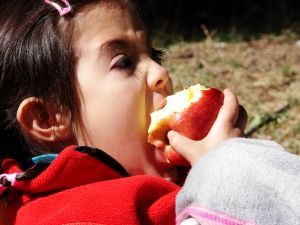By Rita Brhel, managing editor and attachment parenting resource leader (API)
 Most parents who practice Attachment Parenting (AP) aren’t concerned about their children becoming bullies. After all, the goal of AP is to teach children empathy, compassionate, and respect for others – qualities not usually afforded to bullies. But some AP parents may be concerned that their child could become the target of a bully.
Most parents who practice Attachment Parenting (AP) aren’t concerned about their children becoming bullies. After all, the goal of AP is to teach children empathy, compassionate, and respect for others – qualities not usually afforded to bullies. But some AP parents may be concerned that their child could become the target of a bully.
In the Spring 2008 issue of Attachment Parenting International’s The Journal of API, in the “Ask the Founders” feature, API Co-founder Lysa Parker answered a question from a parent about her three-year-old son being the target of bullying by his playmates. This mother’s concern was that his friends were mistaking her son’s kindness and sensitivity for weakness. Parker recommended that the mother use the situation to teach her son and his friends about friendship and how their actions can be hurtful. Parker also said, at this age, talking with the bullies’ parents would be appropriate.
As this boy grows older, the mother does need to teach him how to deal with bullying, Parker said – which can start now: “When your son runs to you for help, he is communicating his need for support, but he also needs to be empowered by learning the words to say to express his feelings.”
This advice is right on target, according to a 1997 article from the National Association for the Education of Young Children, “Teaching Children Not to Be, or Be Victims of, Bullies,” reprinted on the Focus Adolescent Services website www.focusas.com: “The key to promoting positive interactions among young children is teaching them to assert themselves effectively. Children who express their feelings and needs, while respecting those of others will be neither victims nor aggressors.”
AP Prevents Bullying
AP parents, while they may be concerned, are a step ahead of non-AP parents in preventing bullying. As outlined in API’s Eight Principles of Parenting, responding with sensitivity is a critical component of AP. By responding to our infants’ cries, we teach them to trust us as their caregivers and to trust themselves as communicators of their needs.
As children grow, we gradually learn how to let our children become more independent, at their own pace, by watching for their cues. We can encourage them to make their own choices, and therefore learn to become confident in themselves and their abilities, by beginning to allow toddlers to choose what they wear, what game or activity to play next, and so on.
With older children and teens, we can help them discover their talent and develop skills in an area of interest, and let them begin to make larger decisions for themselves, both of which add to a healthy self esteem.
In all of these ways, parents provide their children with tools to thwart bullying incidents.
“Adults must show children that they have the right to make choices – in which toys they play with, or what they wear and what they eat,” according to the National Association for the Education of Young Children article. “The more children trust and value their own feelings, the more likely they will be to resist peer pressure, to respect warm and caring adults, and to be successful in achieving their personal goals.”
How to Teach Assertiveness
The best way to teach assertiveness is by modeling it and accepting it from your children. Parents need to remember that assertiveness is not the same thing as aggression. Instead, as outlined in The-Self-Improvement-Zone’s article “Teach Your Children to Be Assertive” on www.improvementtower.com, assertive behaviors communicate:
- No one has the right to make me feel guilty, foolish, or ignorant.
- I do not need to make excuses for everything I do, although I do need to be accountable to my immediate family and close relatives and myself.
- I am allowed to change my mind, and not feel bad about it.
- It is not necessarily my fault if things go wrong.
- I do not have to know everything, it is OK to say “I don’t know,” and I shouldn’t feel inferior because of that.
- No one is perfect, and it is not the end of the world if I make a mistake.
- Not everyone has to be my friend, and there is nothing wrong with me if someone doesn’t like me.
- If I don’t understand something, it’s OK and I shouldn’t feel inferior.
- I don’t have to prove myself to anyone else.
- I don’t need to be perfect, rather I should strive to just be myself.
Social Skills are Key
Besides teaching these attitudes to their children, parents can also help their children improve their social skills through role-playing to practice social conversation and teach children how to initiate and sustain conversation through both asking and responding to questions and careful listening.
“Teaching them social skills is the first step to making them more comfortable in just about any given situation,” according The-Self-Improvement-Zone. “The more comfortable they feel in these situations, the easier they will learn how to be assertive. The better they understand themselves, the more they will know and articulate their needs.”
Learning How to Handle Frustration Important, Too
Another area where children may need help is in learning how to handle frustration. Parents should teach their children not to use anger as a tool for asserting themselves, as anger creates negative reactions in other people and contributes to communication breakdown. Parents themselves – especially in response to tantrums, hitting, and breaking toys – should never use yelling and punishment as forms of discipline. Instead of anger, parents can teach children how to work out a win-win compromise when appropriate, and when not appropriate, how to relax and let the situation bother them less.
“Keep in mind that the only way you will be able to teach your children how to assert themselves is by learning how to be assertive yourself,” according The-Self-Improvement-Zone. “It is up to you, as the adult, to set the example for your child. No means no. You do not need to become a doormat to ensure that your child becomes assertive. Be a good role model for your children. Children learn what they see and experience. If you are assertive and fair, they will learn to become one, too.”
The best way to teach assertiveness is by modeling it and accepting it from your children.


